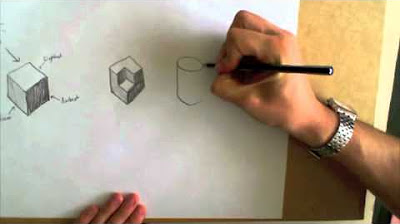Tutorial Menggambar Perspektif 1 titik - Belajar Gambar dari 0 Ep.4
Summary
TLDRThis video tutorial introduces the basics of drawing three-dimensional shapes using perspective. It covers fundamental concepts like horizon lines, vanishing points, and the difference between isometric and one-point perspectives. The video demonstrates practical techniques, such as drawing cubes, cones, and cylinders in perspective, with step-by-step instructions. Emphasizing simplicity for beginners, it encourages viewers to use approximate methods to create realistic illusions of depth, while highlighting the importance of understanding perspective in design. The tutorial also includes tips for creating more complex objects, like tables and rooms, using these principles.
Takeaways
- 😀 Perspective refers to the way objects are represented based on the viewer's angle or point of view.
- 😀 The horizon line represents the viewer's eye level and can be adjusted based on the angle of view.
- 😀 A higher horizon line indicates a higher vantage point, while a lower horizon line shows a lower perspective.
- 😀 Vanishing points occur where parallel lines appear to converge as they recede into the distance.
- 😀 For beginners, focusing on basic principles like the horizon line and vanishing point is essential for drawing in perspective.
- 😀 Isometric perspective ignores the vanishing point and horizon line, maintaining uniform size and angle for objects.
- 😀 One-point perspective includes a single vanishing point, creating depth by showing objects getting smaller as they recede into the distance.
- 😀 The first step in drawing one-point perspective is to draw the horizon line and place the vanishing point along it.
- 😀 To draw 3D shapes like boxes or cubes, start with a 2D shape and extend lines from the corners to the vanishing point.
- 😀 For complex objects, like a table, apply perspective principles to the base and legs to create a realistic three-dimensional effect.
Q & A
What is the main concept of perspective in drawing?
-Perspective in drawing refers to how we represent objects based on their position relative to the viewer's point of view, allowing us to depict three-dimensional objects on a two-dimensional surface.
What is the horizon line, and how does it affect perspective?
-The horizon line represents the viewer's eye level. Its position affects how we perceive objects; if it's low, we see more of the bottom of objects, while a higher horizon line makes us see more of the top.
What is the vanishing point in perspective drawing?
-The vanishing point is the spot where parallel lines appear to converge as they move away from the viewer, creating the illusion of depth. It's an essential element in understanding perspective, especially in one-point perspective.
What is one-point perspective, and why is it recommended for beginners?
-One-point perspective involves using a single vanishing point, which simplifies the process of drawing 3D objects. It's recommended for beginners because it’s easier to grasp and allows for creating depth without complex calculations.
How does the position of the vanishing point affect the perspective of objects?
-The vanishing point determines how objects are seen in terms of distance and size. The closer the vanishing point is to the object, the more dramatic the depth. Moving the vanishing point higher or lower alters the viewer's perspective.
What is the process of drawing objects in one-point perspective?
-To draw objects in one-point perspective, start by drawing a 2D shape, then connect its corners to the vanishing point. This gives the object its depth and realistic proportions according to the perspective.
How do you draw a 3D cylinder in perspective?
-To draw a cylinder in perspective, start with a square or rectangle, then draw circles inside it for the top and bottom. Use the vanishing point to guide the lines and ensure the cylinder maintains realistic proportions.
How do you deal with tilted objects in perspective drawing?
-When objects are tilted, the process remains the same, but the orientation of lines changes. You adjust the lines so they follow the perspective grid, either by making them parallel to existing lines or aligning them to the vanishing point.
What is the process for drawing a cone or pyramid in perspective?
-For a cone or pyramid, start by drawing a circle for the base. Then, connect the edge of the circle to the vanishing point for a cone or to the tip of the pyramid. For a vertical cone, draw a straight line from the center of the circle and connect it to the outer edges.
What is the importance of approximation in perspective drawing for illustrators?
-For illustrators, exact accuracy isn't always necessary. The goal is to create a visual illusion of three-dimensionality, so approximating measurements and angles can often be sufficient to convey depth and perspective.
Outlines

هذا القسم متوفر فقط للمشتركين. يرجى الترقية للوصول إلى هذه الميزة.
قم بالترقية الآنMindmap

هذا القسم متوفر فقط للمشتركين. يرجى الترقية للوصول إلى هذه الميزة.
قم بالترقية الآنKeywords

هذا القسم متوفر فقط للمشتركين. يرجى الترقية للوصول إلى هذه الميزة.
قم بالترقية الآنHighlights

هذا القسم متوفر فقط للمشتركين. يرجى الترقية للوصول إلى هذه الميزة.
قم بالترقية الآنTranscripts

هذا القسم متوفر فقط للمشتركين. يرجى الترقية للوصول إلى هذه الميزة.
قم بالترقية الآن5.0 / 5 (0 votes)






